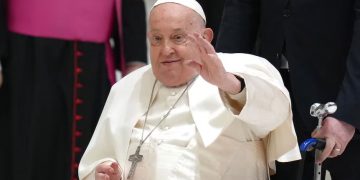In death as in life, Pope Francis remained the shepherd of the unexpected, the humble revolutionary who quietly redefined what it means to wear the shoes of the fisherman.
As the world mourns his passing, it also marvels at the many “firsts” that defined both his papacy and the touching decisions he made for his afterlife.
Born in Argentina, Bergoglio was the first non-European Pope in over a millennium, a move that shook centuries of tradition and symbolized the Church’s pivot toward the Global South.
From the beginning, he embodied a radical humility. In a world used to papal grandeur, he chose simplicity opting out of the lavish Apostolic Palace for a modest guesthouse.
It wasn’t just symbolic it was deeply personal. He washed the feet of prisoners, hugged lepers, and called ordinary Catholics on the phone.
He ditched the traditional red papal shoes, once a symbol of power and martyrdom, for plain black ones shoes that walked the dusty streets of Buenos Aires long before they stepped onto Vatican marble.
And in choosing the name Francis after the poor man of Assisi—he signaled a mission centered on peace, creation, and the marginalized.
Surprisingly, even in death, Pope Francis redefined what it means to be a Pope.
In a move that startled even the most seasoned Vatican observers, his body was laid on the floor, not the ceremonial catafalque used for centuries.
The gesture echoed the poverty he preached dust returning to dust, without opulence.
Even more strikingly, he will not be buried in the traditional triple coffin, a rite steeped in history meant to honor papal dignity. Instead, he asked for simplicity, a single coffin just wood, just earth, just a man.
And in an extraordinary final wish, he requested to be buried outside the Vatican, in the Basilica of St. Mary Major close to the icon of Mary he visited before and after every papal trip.
A Pope who once told the poor “you are not the leftovers of society” chose in death to lie not in a tomb of kings, but in a church of the people.
He also made history as the first Pope to co-exist with a resigned predecessor Pope Benedict XVI in 600 years.
Their relationship, built on mutual respect, created a new model of coexistence between past and present, perhaps even hinting at future reforms of the papacy itself.
Pope Francis has left behind a legacy not of power, but of presence. In his embrace of humility, he became the most radical of Popes one who walked with the poor, welcomed the outsider, and broke centuries of formality for the sake of the Gospel.
In the quiet stillness of St. Mary Major, the Pope of Firsts rests his legacy echoing in the hearts of those who believe that faith should always begin with love.





















